headlamp Citroen DS5 RHD 2015 1.G Owner's Guide
[x] Cancel search | Manufacturer: CITROEN, Model Year: 2015, Model line: DS5 RHD, Model: Citroen DS5 RHD 2015 1.GPages: 396, PDF Size: 12.14 MB
Page 158 of 396
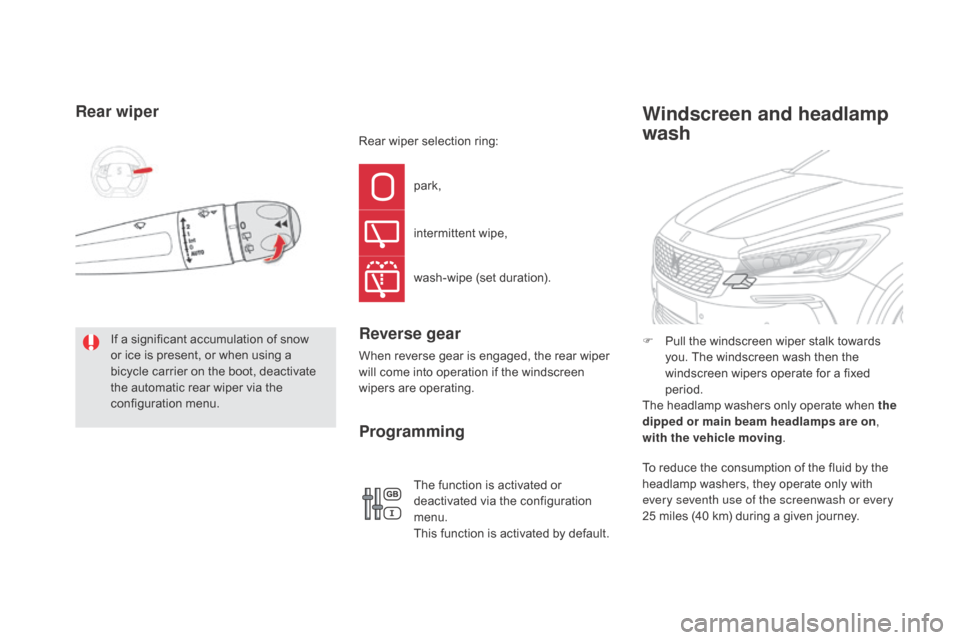
Rear wiper
If a significant accumulation of snow
or ice is present, or when using a
bicycle carrier on the boot, deactivate
the automatic rear wiper via the
configuration menu.park,
intermittent wipe,
wash-wipe (set duration).Reverse gear
When reverse gear is engaged, the rear wiper
will come into operation if the windscreen
wipers are operating.
The function is activated or
deactivated via the configuration
menu.
This function is activated by default.
Programming
F Pull the windscreen wiper stalk towards you. The windscreen wash then the
windscreen wipers operate for a fixed
period.
The headlamp washers only operate when the
dipped or main beam headlamps are on,
with the vehicle moving .
Windscreen and headlamp
wash
Rear wiper selection ring:
To reduce the consumption of the fluid by the
headlamp washers, they operate only with
every seventh use of the screenwash or every
25 miles (40 km) during a given journey.
Page 215 of 396
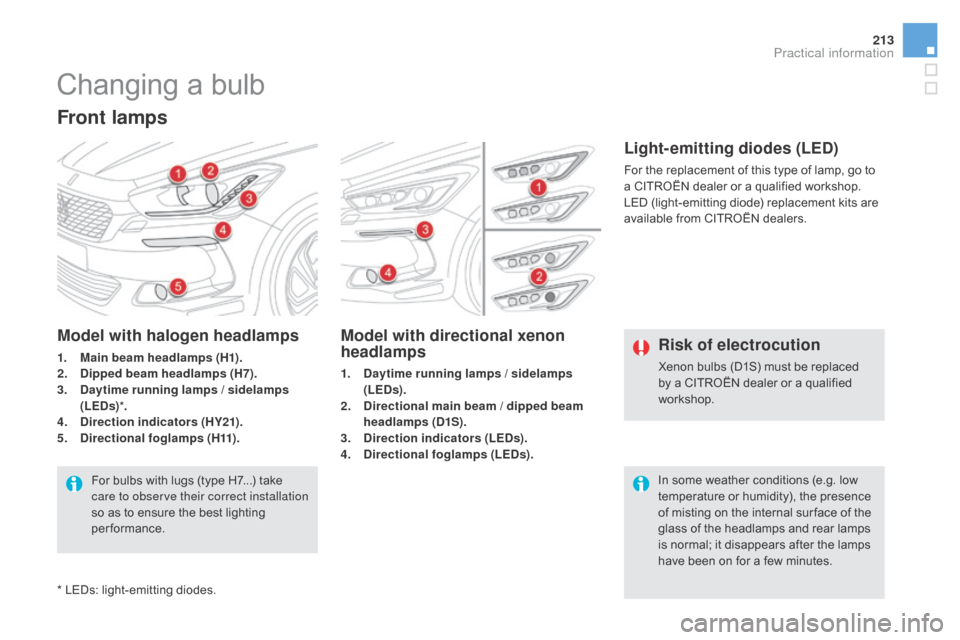
213
Changing a bulb
Front lamps
Model with directional xenon
headlamps
1. daytime running lamps / sidelamps
(LEds ).
2.
di
rectional main beam / dipped beam
headlamps (
d1S
).
3.
di
rection indicators (LE
ds
).
4.
di
rectional foglamps (LE
ds
).
Model with halogen headlamps
1. Main beam headlamps (H1).
2. di
pped beam headlamps (H7).
3.
da
ytime running lamps / sidelamps
(LE
d s)*.
4.
di
rection indicators (HY21).
5.
di
rectional foglamps ( H11) .
For bulbs with lugs (type H7...) take
care to observe their correct installation
so as to ensure the best lighting
performance. In some weather conditions (e.g. low
temperature or humidity), the presence
of misting on the internal sur face of the
glass of the headlamps and rear lamps
is normal; it disappears after the lamps
have been on for a few minutes.Risk of electrocution
Xenon bulbs (D1S) must be replaced
by a CITROËN dealer or a qualified
workshop.
Light-emitting diodes (LEd)
For the replacement of this type of lamp, go to
a CITROËN dealer or a qualified workshop.
LED (light-emitting diode) replacement kits are
available from CITROËN dealers.
* LEDs: light-emitting diodes.
Practical information
Page 216 of 396

The headlamps are fitted with
polycarbonate glass with a protective
coating:
F
d
o not clean them using a dr y
or abrasive cloth, nor with a
detergent or solvent product,
F
u
se a sponge and soapy water or a
pH neutral product,
F
w
hen using a high pressure washer
on persistent marks, do not keep
the lance directed towards the
lamps or their edges for too long,
so as not to damage their protective
coating and seals. Changing a bulb should only be done
after the headlamp has been switched
off for several minutes (risk of serious
burns).
F
D
o not touch the bulb directly with
your fingers, use a lint-free cloth.
It is imperative to use only anti-
ultraviolet (UV) type bulbs to avoid
damaging the headlamp.
Always replace a failed bulb with a
new bulb with the same type and
specification.
daytime running lamps / sidelamps
For the replacement of this type of LED lamp
and lighting guides, contact a CITROËN dealer
or a qualified workshop.
A replacement kit for the LEDs is available from
CITROËN dealers.
Page 217 of 396

215
dipped beam headlamps
(halogen model)
Main beam headlamps
(halogen model)
F Press on the top of the connector then
pivot the assembly downwards.
F
R
emove the connector with the bulb.
F
R
emove the bulb and change it.
For reassembly, carry out these operations in
reverse order, but engaging the bottom of the
bulb first.
F
R
emove the protective plastic cover by
pulling on the tab.
F
R
emove the protective plastic cover by
pulling on the tab.
F
R
emove the connector with the bulb by
pressing on the lug at the bottom.
F
R
emove the bulb and change it.
For reassembly, carry out these operations in
reverse order.
Practical information
Page 225 of 396

223
Engine compartment fuses
The fusebox is placed in the engine
compartment near the battery.
Access to the fuses
F Unclip the cover.
F C hange the fuse (see corresponding
paragraph).
F
W
hen you have finished, close the cover
carefully to ensure correct sealing of the
fusebox. Fuse
n
°
Rating
(A) Functions
F20 15Front / rear screenwash pump.
F21 20Headlamp wash pump.
F22 15Horn.
F23 15Right-hand main beam headlamp.
F24 15Left-hand main beam headlamp.
F27 5Left hand lamp mask.
F28 5Right hand lamp mask.
Practical information
Page 229 of 396
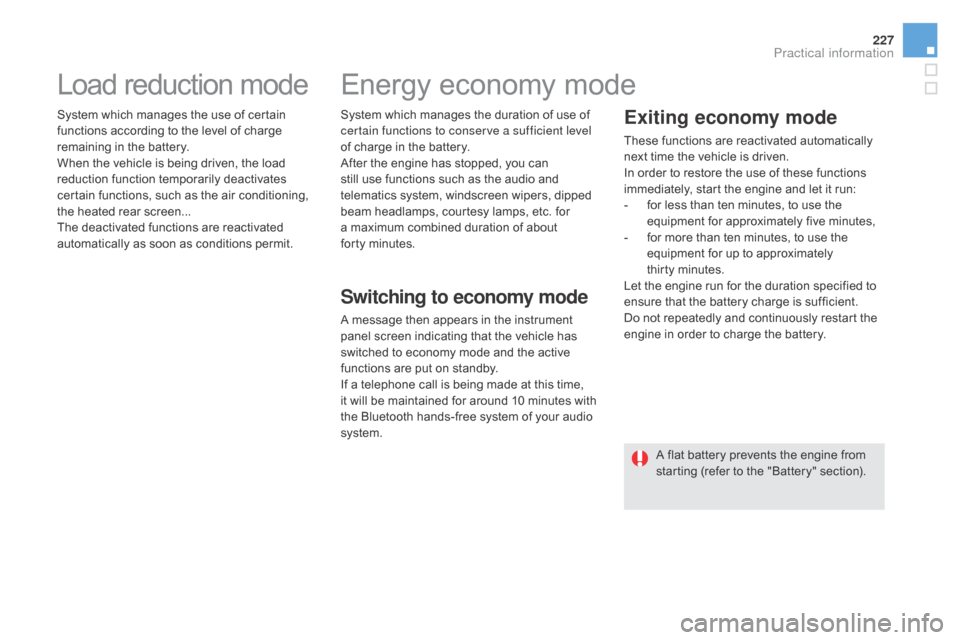
227
Load reduction mode
System which manages the use of certain
functions according to the level of charge
remaining in the battery.
When the vehicle is being driven, the load
reduction function temporarily deactivates
certain functions, such as the air conditioning,
the heated rear screen...
The deactivated functions are reactivated
automatically as soon as conditions permit.System which manages the duration of use of
certain functions to conserve a sufficient level
of charge in the battery.
After the engine has stopped, you can
still use functions such as the audio and
telematics system,
windscreen wipers, dipped
beam headlamps,
courtesy lamps, etc. for
a maximum combined duration of about
forty
m
inutes.
Energy economy mode
Switching to economy mode
A message then appears in the instrument
panel screen indicating that the vehicle has
switched to economy mode and the active
functions are put on standby.
If a telephone call is being made at this time,
it will be maintained for around 10 minutes with
the Bluetooth hands-free system of your audio
system.
Exiting economy mode
These functions are reactivated automatically
next time the vehicle is driven.
In order to restore the use of these functions
immediately, start the engine and let it run:
-
f
or less than ten minutes, to use the
equipment for approximately five minutes,
-
f
or more than ten minutes, to use the
equipment for up to approximately
thirty
m
inutes.
Let the engine run for the duration specified to
ensure that the battery charge is sufficient.
Do not repeatedly and continuously restart the
engine in order to charge the battery.
A flat battery prevents the engine from
starting (refer to the "Battery" section).
Practical information
Page 236 of 396

Advice on care and maintenance
customising stickers
These customising parts are self-adhesive
stickers, treated to give good resistance to
ageing and tearing.
They are intended for customising the body.
Available also as accessories, we recommend
that you have them fitted by a CITROËN dealer
or a qualified workshop.
When washing your vehicle, keep the end of
a high-pressure lance at least 30 centimetres
from the stickers.We strongly advise against cleaning
your vehicle in a high pressure car
wash.
Headlamps and lamps
The headlamps have polycarbonate lenses,
finished with a protective lacquer.
Do not clean them with a dry or abrasive cloth,
nor with detergent or solvent products.
Use a sponge and soapy water.
The use of a high pressure jet wash for
cleaning the headlamps, lamps and their
surrounds may damage the lacquer and seals.
Observe the recommendations on pressure
and distance for jet washing.
First clean persistent stains with a sponge and
warm soapy water.
Recommendations on the care and maintenance your vehicle are given in the maintenance and
warranty guide.
Leather
Leather is a natural product. Appropriate
regular care and cleaning is essential for its
durability.
Refer to your vehicle's maintenance and
warranty guide for information on the special
precautions to observe.
Page 247 of 396
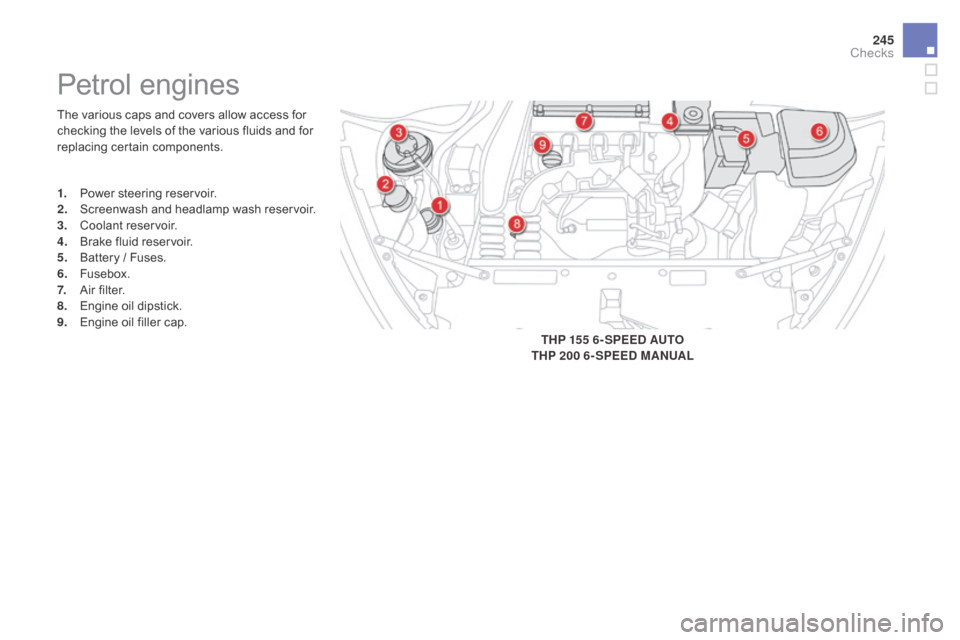
245
The various caps and covers allow access for
checking the levels of the various fluids and for
replacing certain components.
Petrol engines
1. Power steering reservoir.
2. Screenwash and headlamp wash reservoir.
3.
C
oolant reservoir.
4.
B
rake fluid reservoir.
5.
B
attery / Fuses.
6.
F
usebox.
7.
A
ir filter.
8.
E
ngine oil dipstick.
9.
E
ngine oil filler cap. THP 155 6- SPEE
d
AUTO
THP 200 6- SPEE
d
MA
nU
AL
checks
Page 248 of 396
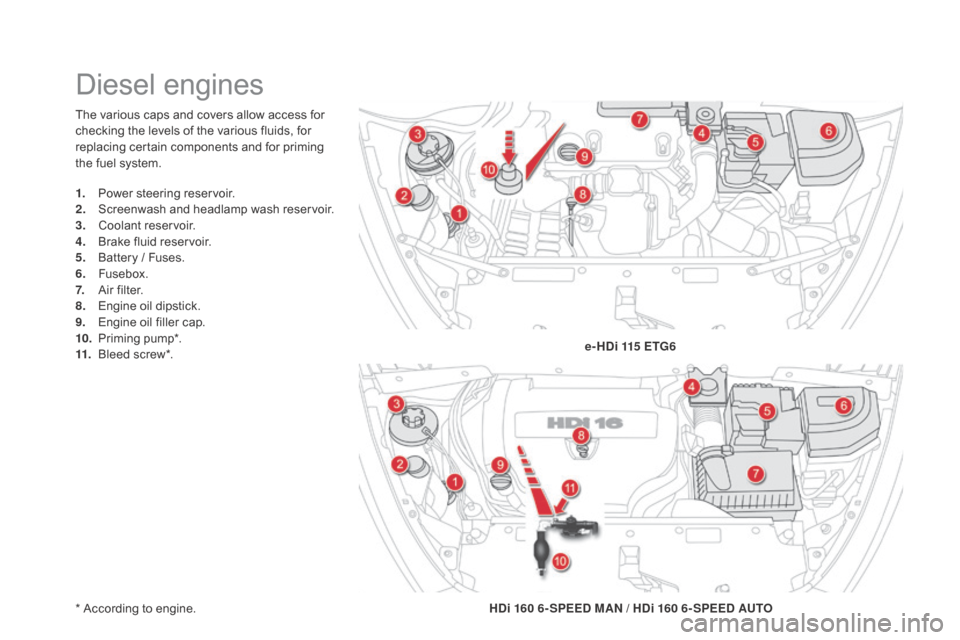
The various caps and covers allow access for
checking the levels of the various fluids, for
replacing certain components and for priming
the fuel system.
* According to engine.
Diesel engines
1. Power steering reservoir.
2. Screenwash and headlamp wash reservoir.
3.
C
oolant reservoir.
4.
B
rake fluid reservoir.
5.
B
attery / Fuses.
6.
F
usebox.
7.
A
ir filter.
8.
E
ngine oil dipstick.
9.
E
ngine oil filler cap.
10.
P
riming pump*.
11.
B
leed screw*. e- H
di 1
15 ET
g6
H
di 1
60 6- SPEE
d
MA
n
/ H
di 1
60 6- SPEE
d
AUTO
Page 252 of 396
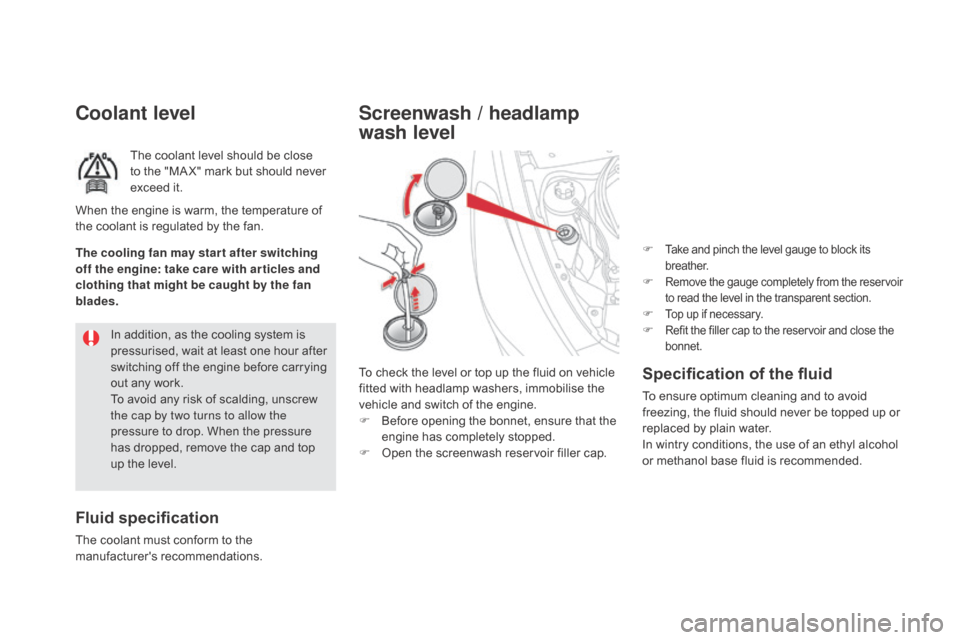
coolant level
The coolant level should be close
to the "MA X" mark but should never
exceed it.
Fluid specification
The coolant must conform to the
manufacturer's recommendations.In addition, as the cooling system is
pressurised, wait at least one hour after
switching off the engine before carrying
out any work.
To avoid any risk of scalding, unscrew
the cap by two turns to allow the
pressure to drop. When the pressure
has dropped, remove the cap and top
up the level.
When the engine is warm, the temperature of
the coolant is regulated by the fan.
The cooling fan may star t after switching
off the engine: take care with ar ticles and
clothing that might be caught by the fan
blades.
Specification of the fluid
To ensure optimum cleaning and to avoid
freezing, the fluid should never be topped up or
replaced by plain water.
In wintry conditions, the use of an ethyl alcohol
or methanol base fluid is recommended.
Screenwash / headlamp
wash level
To check the level or top up the fluid on vehicle
fitted with headlamp washers, immobilise the
vehicle and switch of the engine.
F
B
efore opening the bonnet, ensure that the
engine has completely stopped.
F
O
pen the screenwash reservoir filler cap. F
Take and pinch the level gauge to block its
breather.
F Remove the gauge completely from the reservoir to read the level in the transparent section.
F Top up if necessary.F Refit the filler cap to the reservoir and close the bonnet.